Twin recrystallization mechanisms in a high strain rate compressed Mg-Zn alloy
2021-05-21YuxunLiuYngxinLiQingchunZhuHunZhngXixiQiJinhuiWngPeipengJinXioqinZeng
Yuxun Liu, Yngxin Li,*, Qingchun Zhu, Hun Zhng, Xixi Qi, Jinhui Wng,Peipeng Jin, Xioqin Zeng,,**
a National Engineering Research Center of Light Alloy Net Forming and State Key Laboratory of Metal Matrix Composite, Shanghai Jiao Tong University,200240 Shanghai, PR China
b Qinghai Provincial Engineering Research Center for High Performance Light Metal Alloys and Forming, Qinghai University, Xining 810016, PR China
Received 25 September 2019; received in revised form 19 December 2019; accepted 26 December 2019
Available online 11 August 2020
Abstract
Keywords: Magnesium alloy; High strain rate deformation; Recrystallization; Twin.
1. Introduction
Magnesium alloys, as to date the lightest metallic structural materials that are extensively potential in electronics,automotive and aerospace industries, suffer from poor formability [1-3]. Deformation twinning, which is very important for hexagonal close-packed (hcp) Mg alloys where the criterion of fi e independent slip systems is hard to be satisfie during a general deformation, can act as a supplementary mode to facilitate deformation of Mg alloys [4-6]. In addition to coordinating plastic strain, deformation twins can lead to microstructure refinemen [7-9], which is termed as twinning-induced recrystallization.
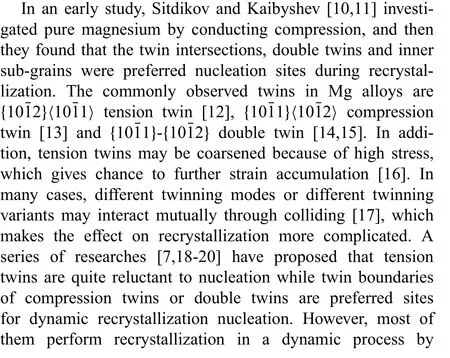
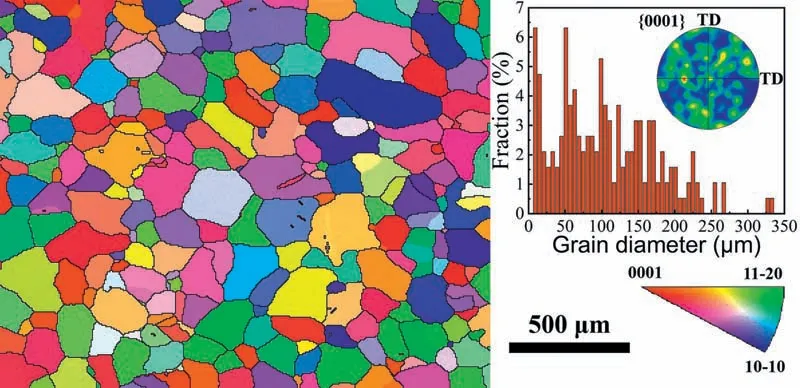
Fig. 1. An EBSD map of the as-cast Mg-1Zn alloy. The insets are the corresponding grain size statistical histogram, {0001} PF and IPF map legend,respectively. Note that the legend applies to subsequent IPF maps hereinafter.
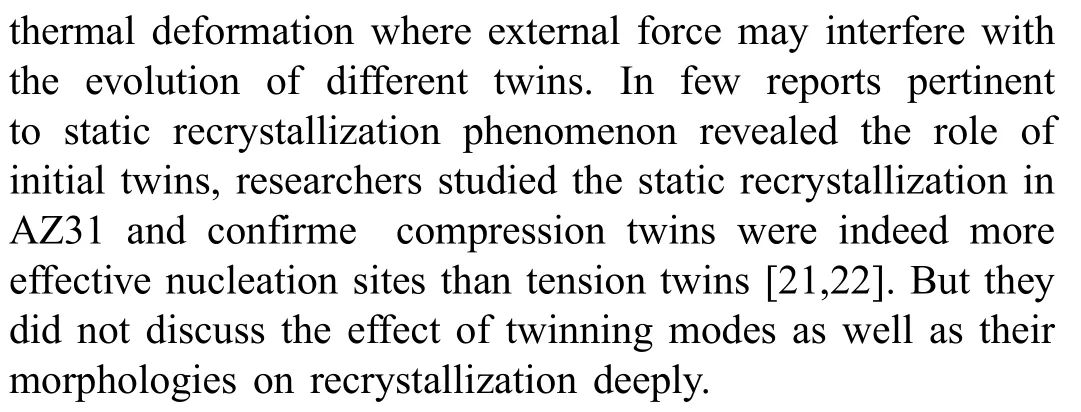
As we know, twinning occurs more frequently with strain rate increases [23] and multiple twinning modes can be achieved in a high-speed deformed Mg alloy. In addition, a Mg-1Zn (wt.%) cast alloy usually contains equiaxial grains without precipitates, which can be a model alloy for studying twin recrystallization mechanisms. Therefore, we herein investigate the microstructure evolution of a high-speed compressed Mg-1Zn with different annealing time, and propose a scheme to compare effects of twin types and their morphologies on static recrystallization.
2. Materials and methods
The experimentally used Mg-1Zn (wt.%) alloy was prepared from high purity (≥99.9%) magnesium and zinc in an induction furnace with a graphite crucible under protection of a mixed atmosphere of CO2and SF6. After melting at 690°C and isothermally holding for 30min, the melt was poured into a steel mold pre-heated at 200°C. Cylindrical samples with diameter of 8mm and height of 6mm were cut from the ingot, then were deformed under high-speed uniaxial compression using a split Hopkinson pressure bar (SHPB) machine with a strain rate of ~103s-1. The impact pressure was 0.3MPa so that the reduction in height could be controlled to 30±3%. Annealing treatment was conducted at 200 °C in silicone oil for different time intervals (15s, 1min, 5min,30min, 4h and 24h). Vickers hardness was measured with a load of 5kg holding for 15s using a XHVT-10Z hardometer. The deformed specimens were sectioned along loading plane and transverse plane, respectively, and then grounded and electro-polished in an ethanol solution with 10% perchloric acid.Microstructures and orientations were investigated by electron backscattered diffraction (EBSD) analysis and postprocessed by a Channel5 software.
3. Results and discussion
3.1. As-cast microstructure
Fig. 1 presents an overview of EBSD inverse pole fig ure (IPF) map of the as-cast Mg-1Zn alloy with a hardness value of 33.8±0.4 HV. The grain size histogram shows an irregular distribution ranging from 6μm to 333μm with an average value of 106μm. The inserted {0001} pole figur(PF) exhibits a max density of 5.5 with many peaks scattering around, which indicates a weak random casting texture.
3.2. High-speed deformed microstructure and twinning modes
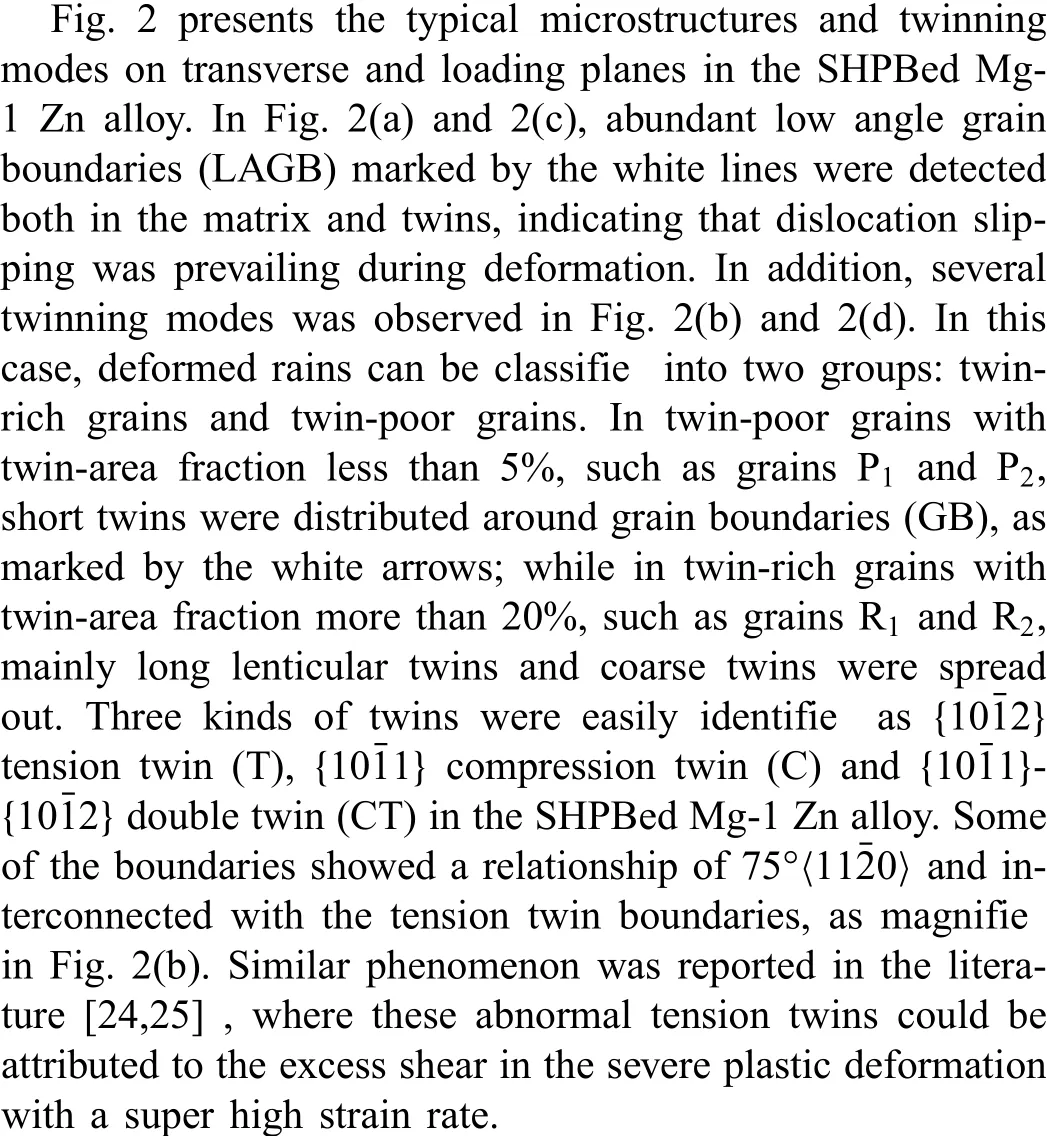
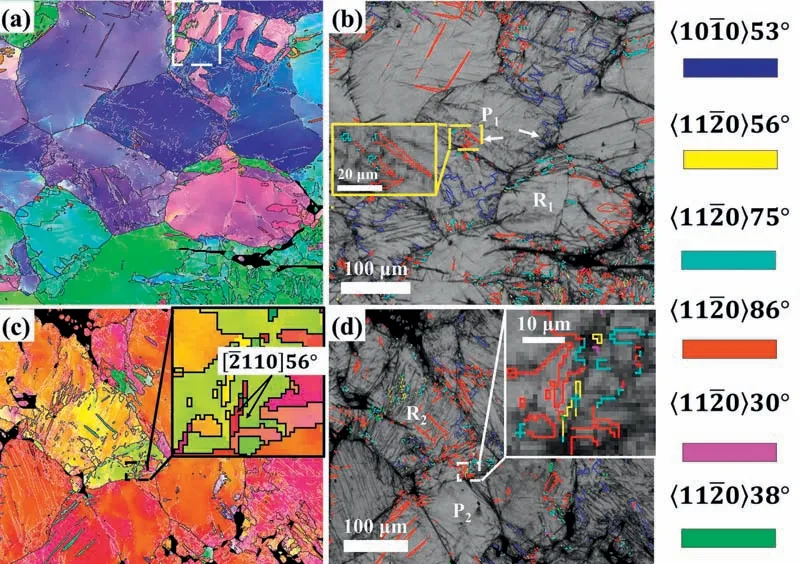
Fig. 2. Microstructures of the SHPBed Mg-1Zn alloy. (a, b) and (c, d) are IPF map and twin distribution on transverse plane and loading plane, respectively.In IPF maps, black line represents HAGB and white line represents LAGB. All IPF maps are polished by clean-up for better observation.
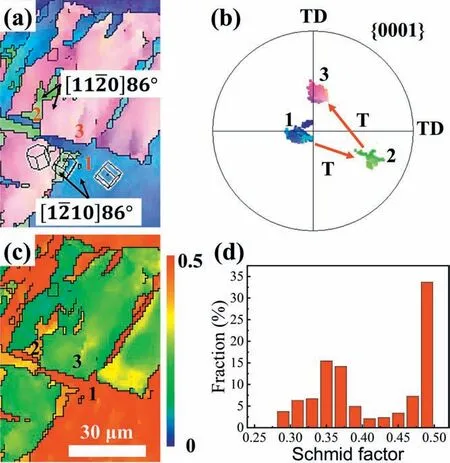
Fig. 3. (a) IPF map, (b) {0001} PF and (c, d) {10¯12}-twin Schmid factor analysis of the white rectangular area in Fig. 2(a). The LAGB was erased for better observation.
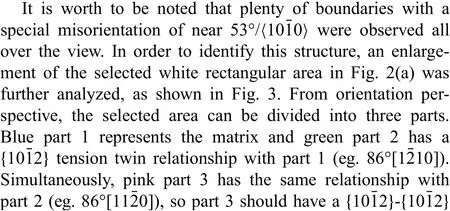
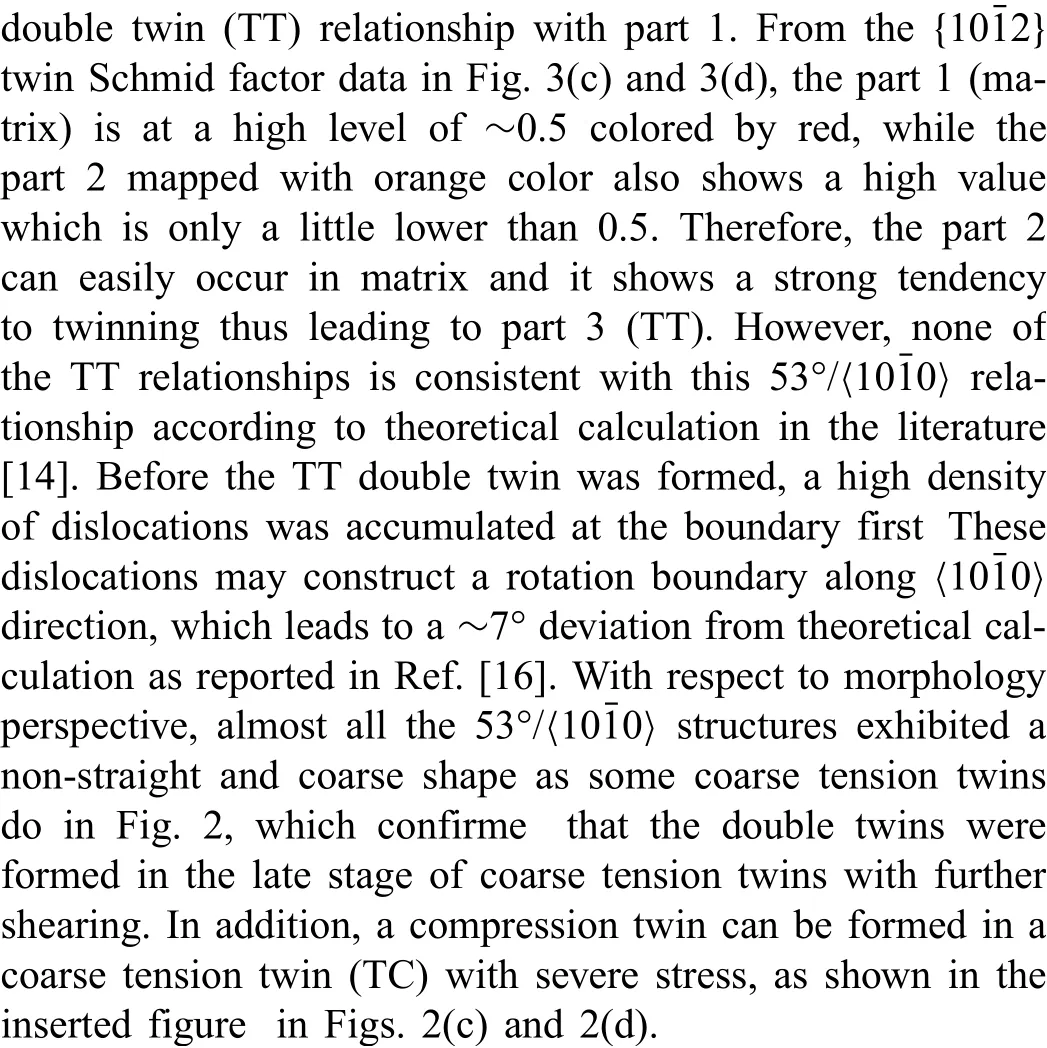
3.3. Hardness change and microstructure evolution during annealing
Annealing treatment was carried out on the SHPBed samples at 200°C for various time intervals. As can be seen in Fig. 4, the hardness of SHPBed samples was 59.1±0.4,nearly two times of the as-cast Mg-1Zn alloy, which should mostly attribute to dislocation hardening and abundant twins.The hardness change hereinafter can be divided into three stages: I-slow descent stage (before 15s), II-fast descent stage(15s - 5min) and III-steady stage (after 5min). And the recrystallization fraction shows a similar trend, namely three ascend stages with different rates.
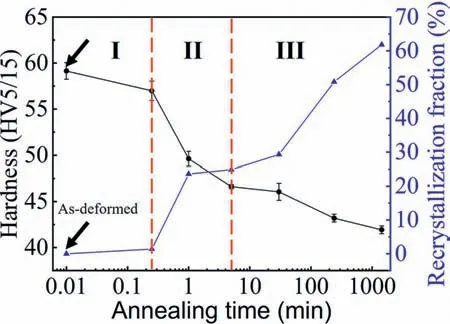
Fig. 4. Hardness and recrystallization fraction variations during annealing.Note that the deformed state is arrowed in the curve for better comparison.
Microstructure evolution and recrystallization process of the SHPBed Mg-1Zn alloy during annealing are illustrated by IPF maps as well as recrystallization maps in Fig.5.After annealing for 15s in Fig. 5(a, b), the microstructure showed little difference comparing with the SHPBed alloy, with a mild decrease of hardness value and a small increment of recrystallization fraction. Recovery was the dominant mechanism in this stage, where substructures were formed before recrystallization started. At 1min annealing seen in Fig. 5(c, d),fin and equiaxed grains emerged to show a necklace shape,with a steep decrease in the hardness value, while the high hardness drop rate remained until annealing for 5min as referred in Fig. 4. Therefore, the hardness decline during the fast stage counts for 60% of the total reduction, mostly owing to recovery and subsequent recrystallization nucleation.In steady stage, equiaxed grains coarsened gradually with increasing recrystallization fraction, while the hardness value remained almost the same. Finally, the hardness value of the Mg-1Zn alloy annealed for 24h was 41.9±0.2 HV, nearly 24% higher than the as-cast alloy.
3.4. Recrystallization mechanisms
To elucidate the recrystallization process and mechanism,three typical stages of annealed Mg-1Zn alloys were selected for further investigation in Fig. 6. A considerable amount of fin recrystallized grains appeared in the SHPBed Mg-1Zn alloy after annealing for 1min, as shown in Fig. 6(a). From a magnifie area of Fig. 6(a) shown in Fig. 6(b), the misorientation between fin recrystallized grains and the matrix fluctuate in ranges of 30°-43° and 50°-61°, which fit with the misorientation of {10¯11}-{10¯12} ,double twins and {10¯11}compression twins, respectively. As reported [19], these twins possess a higher stored energy to accelerate recrystallization.TT double twins were observed to had a higher priority to be nucleated at their boundaries than the generally hard-torecrystallized tension twins during recrystallization, as yellow arrowed in Fig. 6(c). In addition, recrystallization of TC double twins occurred as indicated by white arrows and some equiaxed grains were observed at boundaries near coarse tension twins as black arrowed. With annealing proceeding,grain boundary recrystallization thrived as shown in Fig. 6(d).Meanwhile, long lenticular tension twins were observed nonrecrystallized as referred by the blue rectangle. At the last stage in Fig. 6(e), only lenticular tension twins survived because they were easily detwinning instead of recrystallizing[19,26]. On the basis of experimental results abovementioned,a schematic diagram of recrystallization mechanism was proposed in Fig. 7, showing that {10¯11} compression twin (C)and {10¯11}-{10¯12} double twin (CT) have a higher potential to recrystallize, and some of the coarse tension twins and their inner double twins (TT/TC) may accelerate recrystallization nucleation at their boundaries. In addition, lenticular tension twins(T)are prior to detwinning.Therefore,obtaining more compression twins or coarse twins instead of lenticular tension twins is more effective to accelerate recrystallization process.
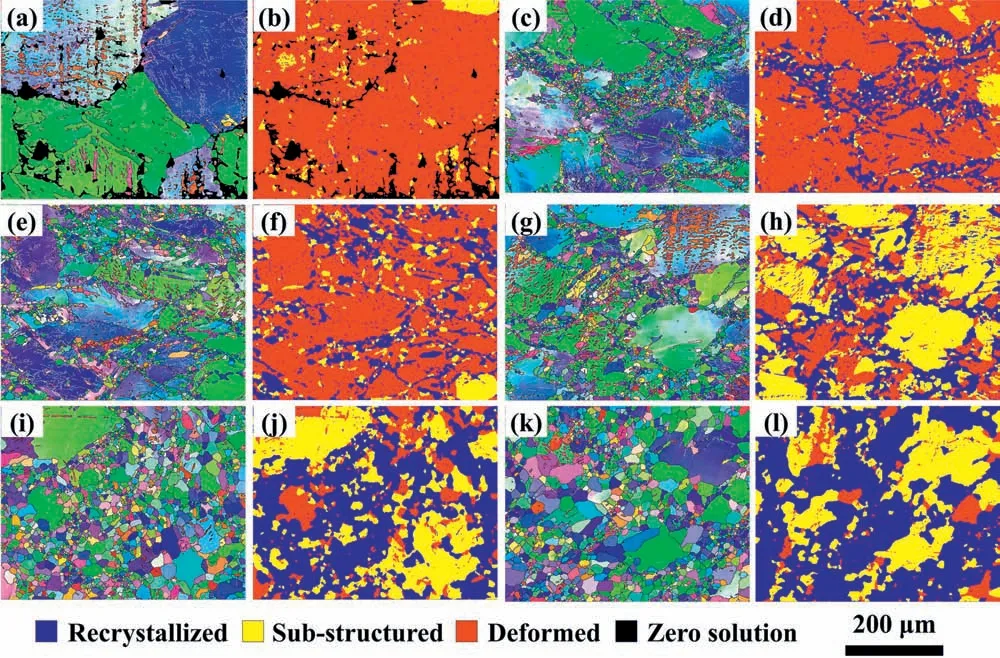
Fig. 5. Microstructure evolution and recrystallization analysis on transverse plane of the deformed samples annealing at 200 °C for (a, b) 15s, (c, d) 1min,(e, f) 5min, (g, h) 30min, (i, j) 4h and (k, l) 24h, respectively. In (b, d, f, h, j, l) recrystallization maps, blue, yellow and red colors represent recrystallized,sub-structured, deformed structures respectively while black color represents zero solution.
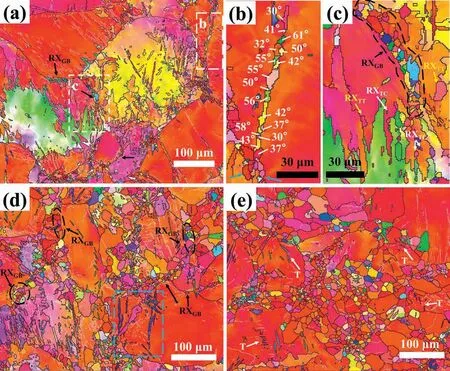
Fig. 6. Microstructures on the loading plane of samples annealed for (a) 1min, (d) 30min and (e) 4h, respectively. (b) and (c) are enlargements of white rectangular area in (a) with LAGB erased for better observation.

Fig. 7. Schematic diagram of recrystallization process in the SHPBed Mg-1Zn alloy. RX represents recrystallized grains.
4. Conclusion
The present paper investigated the static recrystallization process of SHPBed Mg-1Zn alloy, and the conclusions were summarized as follows:

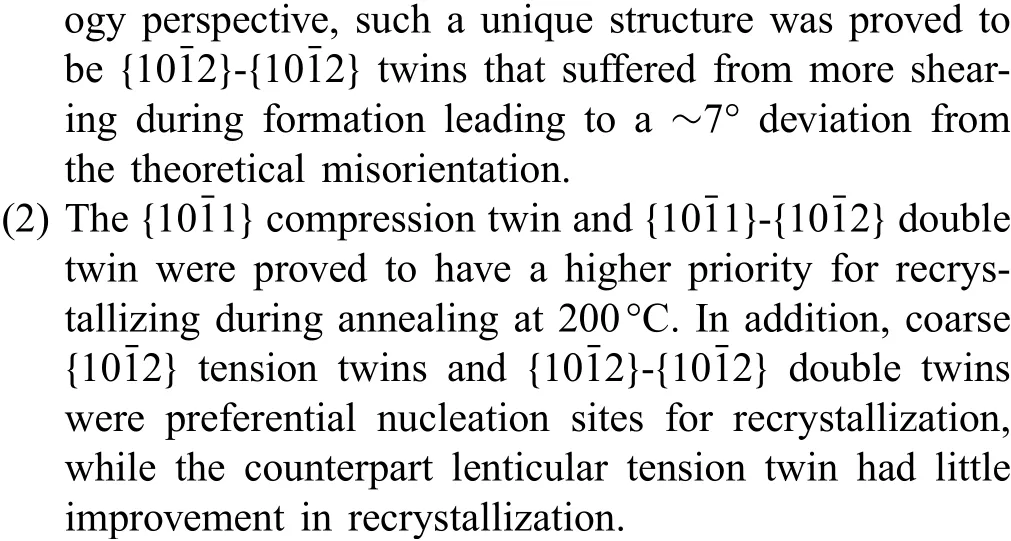
Acknowledgements
The authors would like to thank Prof. Jian Wang from University of Nebraska-Lincoln for insightful discussion.This work is financiall supported by National Natural Science Foundation of China (No. 51701121, No. 51825101), Shanghai Sailing Program(17YF1408800),Science and Technology Commission of Shanghai Municipality (No. 18511109302),Qinghai Provincial Science and Technology Key Program(No. 2018-GX-A1) and Startup Fund for Youngman Research at SJTU (No. 18X100040022).
杂志排行
Journal of Magnesium and Alloys的其它文章
- Mechanism of Mn on inhibiting Fe-caused magnesium corrosion
- An efficien and comparative adsorption of Congo red and Trypan blue dyes on MgO nanoparticles: Kinetics, thermodynamics and isotherm studies
- Corrosion behaviour and cytocompatibility of selected binary magnesium-rare earth alloys
- Correlation between test temperature, applied load and wear transition of Mg97Zn1Y2 alloy
- Residual stress and precipitation of Mg-5Zn-3.5Sn-1Mn-0.5Ca-0.5Cu alloy with different quenching rates
- Preclinical in vivo research of magnesium-based implants for fracture treatment: A systematic review of animal model selection and study design
